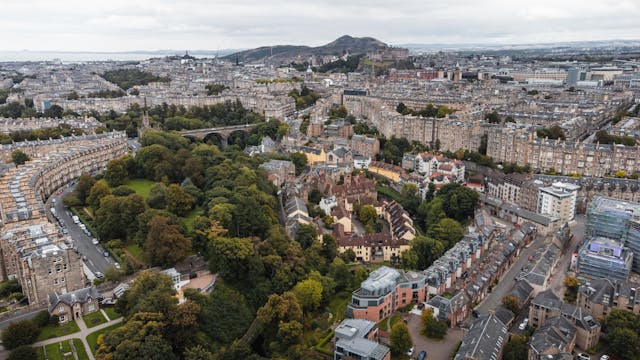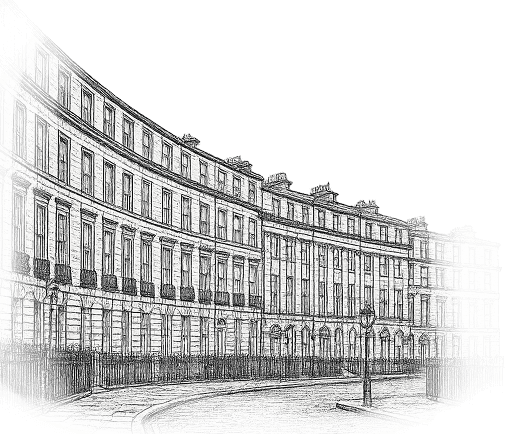Later Period Edinburgh Buildings: chronology of types.
Georgian
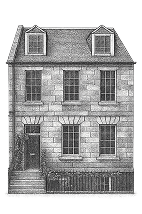
Late Georgian: from the 1790’s until around 1820. Mainly concentrated in the Newtown, Inverleith, Stockbridge, Leith, Portobello and Newington, though isolated examples remain elsewhere. In my view the apex of neoclassicism, if not if architecture itself. Heavily influenced by and in the case of Charlotte Square and some of Queen St, designed by Robert Adam. He was responsible ( together with Wyatt, further South ) for bringing in more light to buildings and to the design of interiors. Heavily influenced by his Grand Tour and the Etruscans, he removed superfluous, heavy detail from his designs, allowing the eye to focus upon the exquisite remaining detail. Though few houses, even in the grander Newtown streets, feature ornamental ceilings in this style, except in halls and cupolas, the ethos remains, throughout the buildings.
Victorian
Technically from 1837 till 1901, though as Scotland lacks buildings typical of the Southern Regency style, 1811 to 1830, I will cede his architectural domain to Victoria, as the stylistic transition was indistinct, save for the more mid – Victorian proliferation of bay windows. At this point, the designs became grander and more substantial. Expect heavier cornices, architraves and ceiling roses. Concave curves became far rarer and convex curves, particularly in hallways, more common. During this period, the burgeoning middle classes also created a demand for detatched and semi- detached houses, eschewing the Palace front, for a more individual, less uniform style.These buildings abound in both the inner and outer Edinburgh suburbs. Tenement flats too, proliferated, of varying degrees of capaciousness and grandeur, filling the areas to the South of Newington, North of Inverleith, West of Calton and huge chunks of Leith. These blocks are often, though not always, distinguishable by tiers of bay windows, the Victorian method of introducing more light together with different aspects to view the outside.
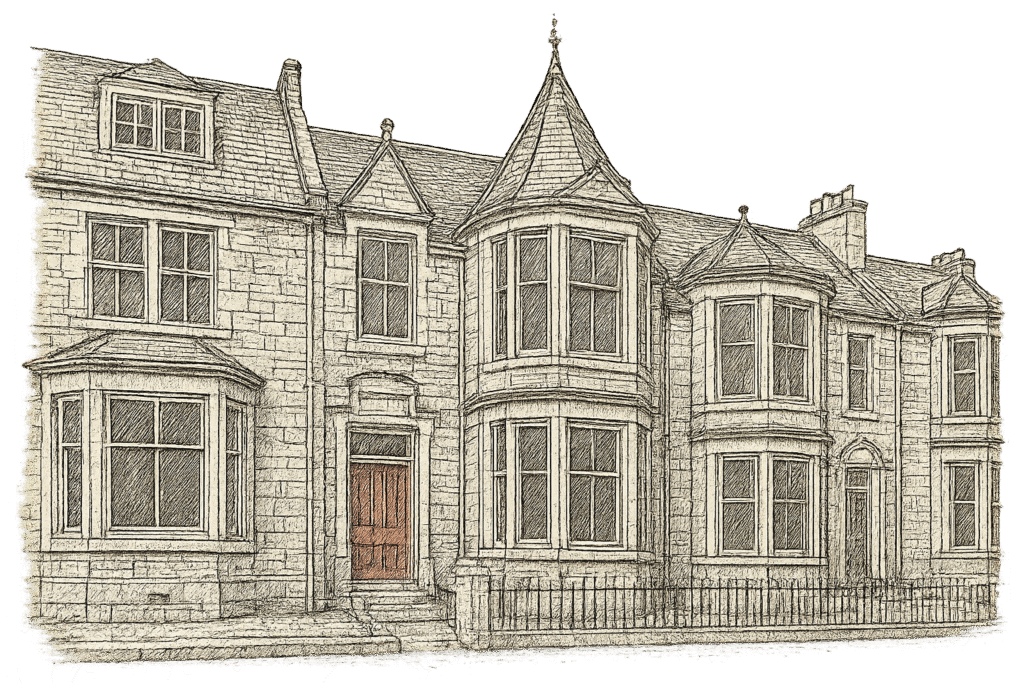
Edwardian
Edwardian: again, though historically between 1901 and 1914, there’s not to much difference between the late Victorian style and this, as they overlapped quite seamlessly. The main difference being that, with the diminishing amount of available space to build, the buildings became more speculative, with slightly, scaled back proportions and often ceiling heights. However, during this period, there was a renewed interest in neoclassicism, giving rise to the late Victorian and Edwardian style of ‘Neo- Georgian’.
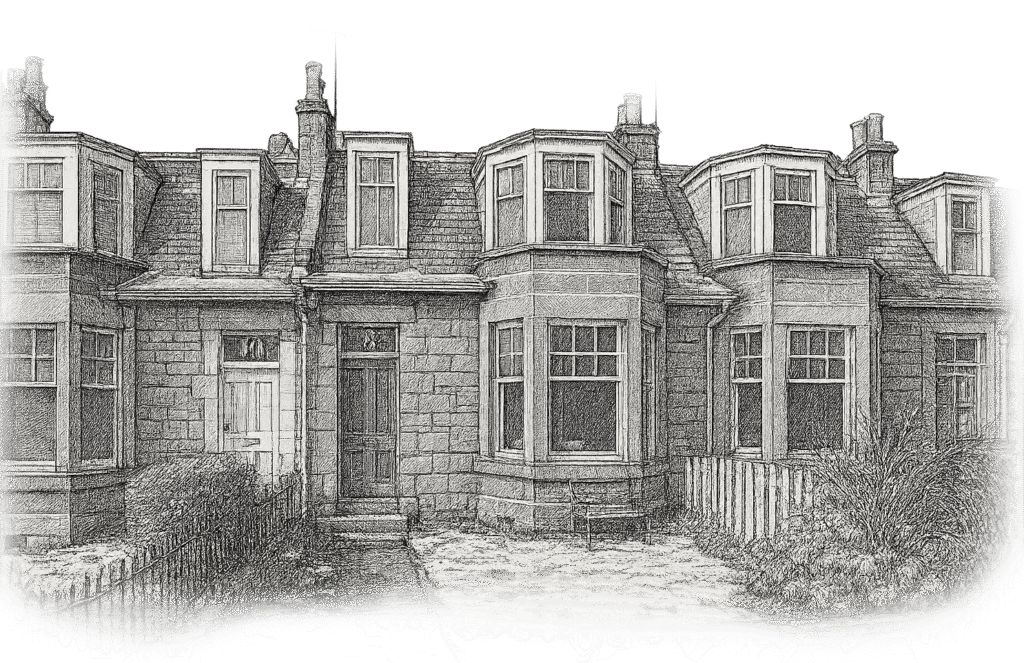
Inter-War
Inter war period: this period was typified by the vast amounts of bungalows which sprouted up in the suburbs and outskirts. Though tenements continued to be built, usually of a more scaled back style.
Differences in Construction of Later Edinburgh Period Buildings
Georgian
Well built, accommodating incredibly fine tolerances on which the fineness of style relied. The main facades were built by one, main contractor, while the interiors were executed by a variety of different firms, to a vast array of styles, leading to a fantastic degree of variation in any given street.
Common faults in construction, aside from the toll of time.
Everything tailored to the goal of symmetry, leading amongst other complications, to rather odd joints where architraves meet.
Built entirely on padstones, not always of sufficient girth.
Often, the masons, the apex trade, would arrogantly leave almost no room for joiners to fit both lath, plaster and working, folding shutters, leading to the common problem of osmotic dampness, even on upper floors, behind bays.
Incredibly shallow breasts at fireplace chimneys, built from very slim stones to accommodate the flue, leading to cracking.
Victorian
Better built than Georgian, with more thorough foundations and general execution. The vast resources of Empire lent an abundance of materials to the process e.g. lightweight box wood to make the massive shutters for bay windows.
Common faults in construction, aside from the toll of time.
Not many but a few.
Plastered ‘hard on’ sometimes on ground floor exterior walls, leading to dampness.
On occasion, complicated roof structures built to match neo romantic aesthetics, causing leaks.
Some terraces built with softer red stone that erodes more.
Edwardian
Sometimes more skimpily. built than predecessors, probably due to speculative build.
Common faults, aside from time itself.
Exposed wooden beams e.g. at recesses originally installed squint.
Thinner plaster.
Often, inadequate solum space. Sometimes ground floor joists are actually touching the earth.
Generally lower standard of execution.
Inter War Year Properties
Faults, aside from time.
Usually better constructed than Edwardian, often using fir wood for architraves etc. rather than pine.
The most common fault arising from methods is the use of finer aggregate in the straightening coats of plaster, leading to cracking and delamination.
Though I have couched this history in terms of general construction, most of these faults are reflected in the type of problems to expect from houses of these periods.
Roof leaks lead to damaged ceilings, osmosis to damp detaching plaster, foundation movement to cracking etc. However, that is not to say that your building, from either of these distinct periods, will suffer from all, or any, of these faults and conversely could suffer from faults more commonly associated with an older or younger building. More positively, it is definitely true to say that owning a period property, if maintained, it is likely that you will encounter far fewer problems, in the long term than the euphemistically termed ‘ New build’.
How Alchemy Plaster Can Help
If you require a company delivers exceptional craftsmanship to preserve and enhance the architectural integrity of your period or modern property Alchemy Plaster can help.
Operating primarily in South East Scotland, we specialise in the restoration of Georgian, Victorian, and Edwardian interiors, including traditional lime-based techniques and a profound understanding of period construction methods. Our services also encompass general plastering for contemporary buildings, ensuring durability and a refined finish.
We offer a full range of traditional and contemporary plastering services – from listed building restoration and hand-run cornices to expert ceiling repairs and modern interior finishes – all delivered with an uncompromising commitment to craftsmanship.
Contact Alchemy Plaster to discuss your requirements and arrange a plastering quotation.
